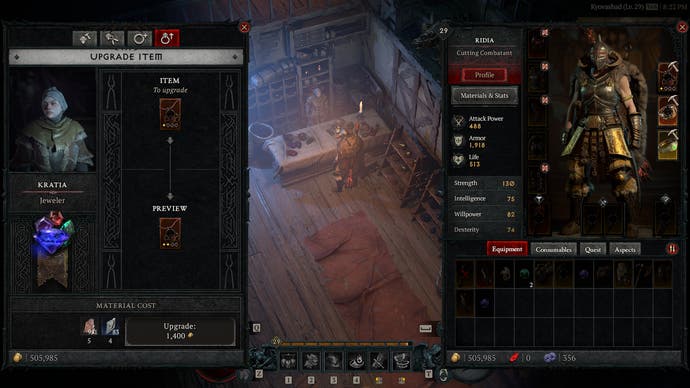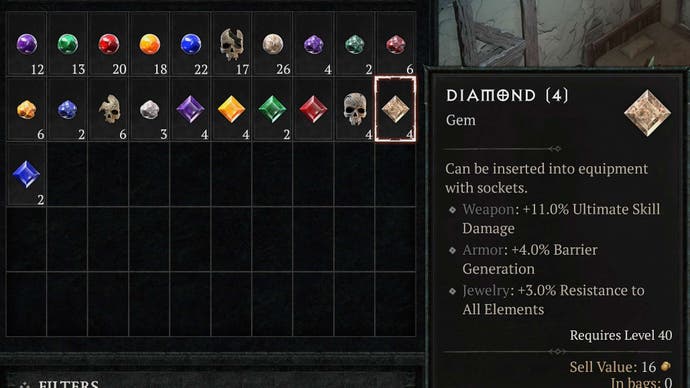Diablo 4 Gem list, how to unlock the jeweler and gem crafting explained
How to acquire Gem Fragments and take your build to the next level.
You'll want to know about Gems in Diablo 4 - now on Game Pass - and how they work since they are a fundamental aspect of the character build and customisation you'll no doubt partake in as you progress through the game.
In Diablo 4, it's not entirely just about the individual pieces of gear you equip, but also the skills you use and stats you improve, whether that's via the gear itself, or the Gems you use to upgrade that gear.
With all that in mind, we've prepared this article that delves into everything you need to know about Diablo 4 Gems, as well as how to unlock the Jeweler, and how to craft gems with Gem Fragments.
On this page:
Diablo 4 Gems explained
Gems are stones you can put into pieces of equipment to raise certain core stats or improve aspects of your character and you equip them via the Character menu - selecting a specific Gem will allow you to socket it into any of the pieces of armor or weapons you have with open Gem sockets.
The types of Gem you can find in Diablo 4 are:
- Ruby
- Amethyst
- Emerald
- Topaz
- Sapphire
- Diamond
- Skull
Gems are a good way of enhancing your gear since - depending on what item they are socketed to - they increase various stats including additional damage, health, elemental resistances, and more. In Diablo 4, there are five tiers of Gem. Ranging from the most basic Crude Gem up to Royal Gems, each subsequent tier improving the associated stats more than the last.

As mentioned, Gems provide various bonuses and which particular stat increase is active depends on what gear they are socketed to. For example, when socketed to weapons, Gems will generally provide some kind of damage bonus, whereas when applied to armour you'll receive some kind of defensive bonus. Alternatively, when slotted into jewelry, you'll receive either damage resistance or bonus armour depending on the gem being used.
How to unlock the Jeweler in Diablo 4
To be able to collect and socket Gems into your gear, you'll first need to unlock the Gem Crafting vendor via its associated quest.
When Diablo 4 first launched in June 2023, the 'Gem Crafting' priority quest appeared once reaching level 20, and you'd be able to accept and complete the associated tutorial for Gem Crafting by visiting the vendor in Kyovashad, within the Fractured Peaks region.
Since the acquisition, storage and crafting of gems underwent a renovation with Season 2's release in October 2023, it's possible this quest might appear earlier as a result. Either way, just keep your eye out for the Gem Crafting quest once you hit level 20, or visit one of the Jewelers in whichever town or city you can find them to see if they have anything on offer. Regardless of when it becomes available, you'll still be able to collect Gem Fragments ready for when the feature is available to use.

Once you've unlocked the Jeweler, on top of the ability to craft gems, you'll also have access to various other features such as unsocketing gems from your existing gear, the ability to increase the number of Gem sockets a piece of gear has, as well as upgrade any Jewelry you have. Each of these services require varying amounts of Gold and materials you'll have found in the world however, and so perhaps you might want to hold onto these until you start acquiring gear you're set on using for specific builds.
How to craft Gems in Diablo 4
Since the change in Season 2, Gems are now primarily crafted via Gem Fragments you collect as you defeat enemies, complete activities and quests in the world. Instead of being stored in your inventory, they are now found within the Materials tab instead, which you can access via the character screen.

As you increase your level, you'll unlock higher tiers of gem quality that can be crafted ranging from Crude to Royal - below are the full list of quality tiers:
- Crude
- Chipped
- Normal
- Flawless
- Royal
The higher the quality, the more Gem Fragments and Gold is required to craft, and the higher the level required to be able to craft it. As for the exact level requirements on when they can be crafted, some of the higher gem qualities won't actually show up until you reach their required level, and when they do, they require greater amounts of gem fragments to craft.

With gem crafting being unlocked at level 20 - and two tiers being craftable right from the getgo - it looks to be every 10 or 20 levels following level 20 that you'll unlock the next tier of Gem. With that in mind, by around level 70 or 80, you should have crafting access for all five tiers of Gem across every type.
To recap then, there are seven different Gem types, each with five tiers of quality that determines the amount a stat will be boosted by when that Gem is socketed into a piece of gear.
Below we've gone through each of these Gem types, the general types of materials required to craft them, and the stats that each one boosts when equipped:
| Type of Gem | Materials Needed to Craft | Stat Bonuses |
|---|---|---|
| Ruby | Gem Fragments and Gold | Weapon: Additional Overpower Damage Armor: Additional Maximum Life Jewelry: Fire Resistance |
| Amethyst | Gem Fragments and Gold | Weapon: Additional Damage Over Time Armor: Damage Taken Over Time Reduction Jewelry: Shadow Resistance |
| Emerald | Gem Fragments and Gold | Weapon: Additional Critical Strike Damage to Vulnerable Enemies Armor: Additional Thorn damage Jewelry: Poison Resistance |
| Topaz | Gem Fragments and Gold | Weapon: Additional Basic Skill damage Armor: Damage Reduction while Control Impaired Jewelry: Lightning Resistance |
| Sapphire | Gem Fragments and Gold | Weapon: Additional Critical Strike damage to Crowd Controlled enemies Armor: Damage Reduction while Fortified Jewelry: Cold Resistance |
| Diamond | Gem Fragments and Gold | Weapon: Additional Ultimate Skill damage Armor: Additional Barrier Generation Jewelry: Additional Resistance to all elements |
| Skull | Gem Fragments and Gold | Weapon: Life granted on Kill Armor: Additional Healing received Jewelry: Additional Armor |
As a reminder, the stat bonuses will be granted depending on which type of gear you slot it into, and the higher the quality (e.g. Chipped, Normal, Flawless etc.) the greater the strength of the stat boost.
For more on Diablo 4, be sure to check out our full list of tips and tricks, as well as how to unlock mounts and how to earn XP and level up fast - all of which are useful for those getting into the game for the first time.








